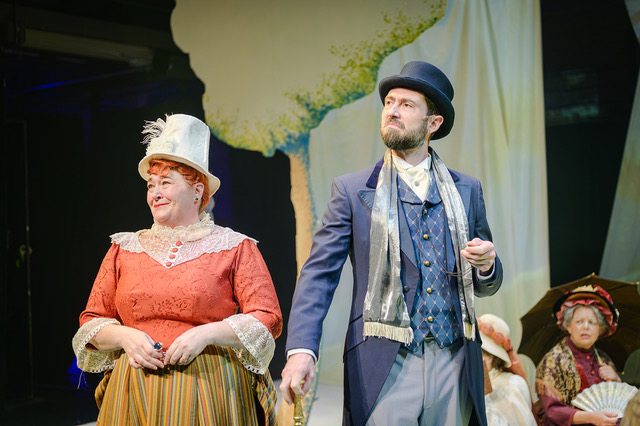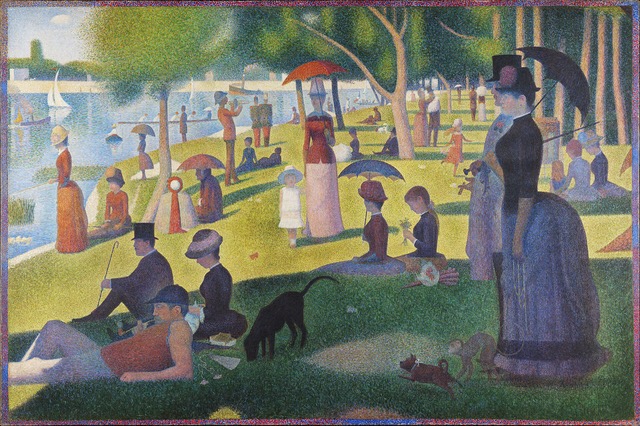Front Porch’s ‘Sunday in the Park with George’ Paints a Powerful Picture

In 1884, French artist George Seurat submitted his first large-scale impressionistic work, entitled Bathers at Asnières, for exhibit at the National Salon in Paris. His work was rejected. Undaunted that same summer, he embarked on dozens of new sketches and studies to create a second large work (9.8’ x 6.6’) he named Un Dimanche après-midi à l’Île de la Grande Jatte. This work was accepted for exhibition in 1886 at the Paris Salon of the Société des Artistes Indépendants and has ever since become the most famous example of Neo-Impressionism discussed in art history classes the world over. Seurat died in 1891 at the age of just 31.
In 1984 Stephen Sondheim and James Lapine brought to Broadway their collaboration of a fictional tale of George Seurat’s fascination with his painting technique, known today as pointillism, and of his supposed relationship with the many characters he depicted in his most famous work. Sunday in the Park with George, although first proven Off-Broadway, became a moderate hit when it opened on Broadway at the Booth Theatre on May 2, 1984. Mandy Patinkin and Bernadette Peters starred. The show ran for 604 performances, closing late in 1985.
Stephen Sondheim, who should need no exposition of his earlier works or courageous musical compositions, addressed his thematic voice with orchestration and lyrics in a staccato-like style, a very decided expression of the pointillism with which his hero George painted. For most of the songs he created for Sunday in the Park, the accompanying lyrics are single words or very short phrases which defy the expectations of ears attuned to more melodic show tunes. For this reason, among others (including a large cast as well as a second act that seems mostly artificial and unnecessary), Sunday in the Park is a difficult musical to stage, especially if great vocal talent can’t be found.
Sacré bleu, Front Porch Theatricals has defied all odds, staging a production of this landmark work that will not be soon forgotten. Time after time, one production after the next, Front Porch and its producers Bruce E. G. Smith and Nancy Zionts have shown a courage (perhaps as great as Sondheim’s own) to stage work that is stunning, triumphant and always one step beyond magical.
So, let’s start with the talent on stage at the New Hazlett Theater. Aaron Galligan-Stierle and Saige Smith lead the show as George and his love interest, Dot, respectively. Galligan-Stierle carries a tenor and tenacity of breath (in other words, boy, can he hold his notes) no greater, but certainly no less, than Mandy Patinkin proved time and again in his long stage career. A “double threat”—an actor who can sing or a singer who can act—Galligan-Stierle exceeds every expectation of performing in a role uniquely created for Patinkin’s voice and mannerisms. Add to this the stellar, stunning and stirring talent of Saige Smith. She’s no Bernadette Peters because she can play any role, and has often, most recently with Front Porch in their spring musical Baby, but also in dozens of local productions. A local reporter in 2020 wrote about her intent to move to New York to pursue the stage; how lucky is Pittsburgh to have her talent still on our own stages. Yet, with a performance like the one she delivered on opening night of Sunday in the Park she has every right and reason to claim her due fame elsewhere. Both Galligan-Stierle and Smith are alone (better yet, together) worth the price of admission for this spectacular show.

Oh, but this production is filled with much, much more talent. Standouts include Daphne Alderson as George’s supposed mother who disdains the changing landscape of the Paris she once knew, Becki Toth as Yvonne, the lively wife of a smug artist who thinks his work is superior to George’s, Brad Smoak as that same artist, Jules, who proves to be more than just smug, and Christy Rodibaugh, playing dual roles as Nurse and “Mrs.” (an American tourist) in just the first act alone. The cast is so tight, so comfortable on stage, a production such as this is so rare when actors pull their own weight in requisite measure to the leads. Of course, there has to be one clunker in the lot; for good humor, he’s a wooden soldier!
Of course, one of the great stars on the Front Porch stage is the framed scrim on which is projected George Seurat’s masterpiece. It’s a functional piece of art that frames time, movement, technique, color, shadow and all the components that are both woven into the final composition, but also the interweaving story of this cast of characters Seurat depicted on his Parisian isle. James Lapine, who wrote the book for Sunday in the Park (and, perhaps, more famously wove together all of the fairy tales in his later collaboration with Sondheim, Into The Woods) cleverly justifies the painting’s inclusion of so many curious characters, intertwining their livelihoods and libidos in a tight, neat treatment that makes up Act One.

Act Two jumps the calendar exactly 100 years ahead to a gallery opening at the Art Institute of Chicago in 1984. Here, the supposed great grandson of Seurat (again, played by Galligan-Stierle) is unveiling a new digital technology he calls Chromolumes, and his grandmother Marie (likewise, Smith), age 98, is there to reflect on their family ancestry. Marie’s supposed mother is the daughter that Seurat sired with Dot and then dismissed when, in Act One, Dot decides to leave for America. None of this is remotely true because Seurat had two children, both of whom died in early childhood. But Sondheim and Lapine’s point in bridging two different worlds of art is to reflect on the challenges of an industry that can only succeed through the generosity of benefactors and their commissions. If Sunday in the Park was written as a study of the artiste and the world he is dedicated (or, perhaps, subjected) to depict, neither the invention of Chromolumes nor this second act do much to help. Far be it from me to second guess Lapine or Sondheim, but this second act is as hollow as the first one teems with an abundance of character, voice, movement and musical integrity. The act does include some very creative staging and it offers one great number, “Move On,” which one has to believe was originally written for Act One. Oh well, the point is that all artists struggle, as apparently Lapine and Sondheim did with Act Two before opening Sunday in the Park to early mixed reviews.
No praise for Front Porch Theatrical’s bold decision to produce this magnificent production should go without purposeful and plenary applause for the costuming. Michelle Nowakowski brought to each of a dozen characters rich and colorful fabrics, hoops and bustles, tall hats and parasols, all of which had to match Seurat’s original vision. Perhaps equal credit must shower upon scenic designer Johnmichael Bohach whose stage serves as canvas, palette, easel, and frame for Joe Spinogatti’s exceptional projections and Forrest Trimble’s beautiful lighting design. And then there is as much to exclaim about the incredible orchestra, sound design and stage direction of this challenging work. Credit is thus due to Camille Villapando Rolla (music director and conductor,) Angela Baughman and Josh Bruton (co-sound designers,) and, of course, to the show’s director Rob James. Rachel Ferrari-Engel managed the properties. Michelle K. Engleman served as stage manager, and Danielle Paccione as production manager. A tall Parisian hat tip to all.
Sunday in the Park with George is scheduled to play at the New Hazlett Theater only through August 24. No theatergoer should hope to find a more polished and professional production of any Sondheim work in Pittsburgh anytime soon. Sunday satisfies, but going on a Wednesday, or Saturday will please just as much.

Photos: Friedman Wagner-Dobler
C. Prentiss Orr is a Pittsburgh-based writer who covers theater and other topics for Entertainment Central. He is the author of the books The Surveyor and the Silversmith and Pittsburgh Born, Pittsburgh Bred.
Share on Social Media
Follow Entertainment Central
Latest Stories
Sign up for the EC Newsletter







